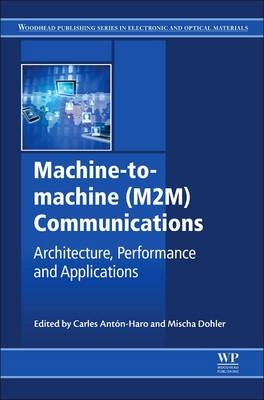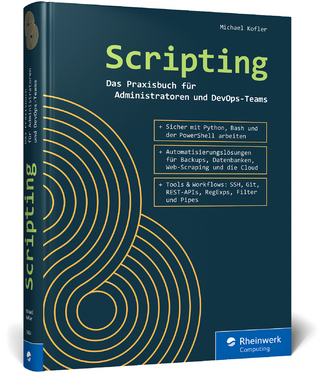
Machine-to-machine (M2M) Communications
Woodhead Publishing Ltd (Verlag)
978-1-78242-102-3 (ISBN)
Machine-to-machine communications refers to autonomous communication between devices or machines. This book serves as a key resource in M2M, which is set to grow significantly and is expected to generate a huge amount of additional data traffic and new revenue streams, underpinning key areas of the economy such as the smart grid, networked homes, healthcare and transportation.
Mischa Dohler, Professor in Wireless Communications at King's College London, UK
List of contributors
Woodhead Publishing Series in Electronic and Optical Materials
1: Introduction to machine-to-machine (M2M) communications
Abstract
Acknowledgment
1.1 Introducing machine-to-machine
1.2 The machine-to-machine market opportunity
1.3 Examples of commercial and experimental M2M network rollouts
1.4 Machine-to-machine standards and initiatives
1.5 Book rationale and overview
Part One: Architectures and standards
2: Overview of ETSI machine-to-machine and oneM2M architectures
Abstract
2.1 Introduction
2.2 Need and rationale for M2M standards
2.3 Standardized M2M architecture
2.4 Using M2M standards for “vertical domains, the example of the smart home
2.5 Conclusions and future trends for M2M standardization
3: Overview of 3GPP machine-type communication standardization
Abstract
3.1 Introduction
3.2 Pros and cons of M2M over cellular
3.3 MTC standardization in 3GPP
3.4 Concluding remarks
4: Lower-power wireless mesh networks for machine-to-machine communications using the IEEE802.15.4 standard
Abstract
Acknowledgments
4.1 Introduction
4.2 The origins
4.3 Challenges of low-power mesh networking
4.4 The past
4.5 The present
4.6 The future
4.7 Conclusion
5: M2M interworking technologies and underlying market considerations
Abstract
5.1 Interworking technologies for M2M communication networks: introduction
5.2 A panorama of heterogeneous technologies
5.3 From capillary to IP networks
5.4 Going up to the M2M cloud
5.5 M2M market as internetworking enabler
5.6 Future trends
6: Weightless machine-to-machine (M2M) wireless technology using TV white space: developing a standard
Abstract
6.1 Why a new standard is needed
6.2 The need for spectrum
6.3 TV white space as a solution
6.4 Designing a new technology to fit M2M and white space
6.5 Weightless: the standard designed for M2M in shared spectrum
6.6 Establishing a standards body
6.7 Conclusions
7: Supporting machine-to-machine communications in long-term evolution networks
Abstract
Acknowledgments
7.1 Introduction to M2M in LTE
7.2 Main technical challenges and existing solutions
7.3 Integrating MTC traffic into a human-centric system: a techno-economic perspective
7.4 Business implications for MTC in LTE
7.5 Conclusions
Part Two: Access, scheduling, mobility and security protocols
8: Traffic models for machine-to-machine (M2M) communications: types and applications
Abstract
8.1 Introduction
8.2 Generic methodology for traffic modeling
8.3 M2M traffic modeling
8.4 Model fitting from recorded traffic
8.5 Conclusions
9: Random access procedures and radio access network (RAN) overload control in standard and advanced long-term evolution (LTE and LTE-A) networks
Abstract
Acknowledgments
9.1 Introduction
9.2 E-UTRAN access reservation protocol
9.3 Extended access barring protocol
9.4 Alternative E-UTRAN load control principles
9.5 Overview of core network challenges and solutions for load control
9.6 Ongoing 3GPP work on load control
9.7 Resilience to overload through protocol re-engineering
9.8 Conclusion
10: Packet scheduling strategies for machine-to-machine (M2M) communications over long-term evolution (LTE) cellular networks
Abstract
10.1 State of the art in M2M multiple access in legacy cellular systems
10.2 Signaling and scheduling limitations for M2M over LTE
10.3 Existing approaches for M2M scheduling over LTE
10.4 Novel approaches for M2M scheduling over LTE
10.5 Technology innovations and challenges for M2M scheduling over wireless networks beyond 2020
10.6 Conclusions
11: Mobility management for machine-to-machine (M2M) communications
Abstract
Acknowledgments
11.1 Introduction
11.2 Use cases for M2M mobility
11.3 Challenges of M2M mobility
11.4 Infrastructure considerations for mobility in M2M
11.5 State-of-the-art solutions
11.6 Summary and conclusions
12: Advanced security taxonomy for machine-to-machine (M2M) communications in 5G capillary networks
Abstract
12.1 Introduction
12.2 System architecture
12.3 System assets
12.4 Security threats
12.5 Types of attacks
12.6 Layers under attack
12.7 Security services
12.8 Security protocols and algorithms
12.9 Concluding remarks
13: Establishing security in machine-to-machine (M2M) communication devices and services
Abstract
13.1 Introduction
13.2 Requirements and constraints for establishing security in M2M communications
13.3 Trust models in M2M ecosystems
13.4 Protecting credentials through their lifetime in M2M systems
13.5 Security bootstrap in the M2M system
13.6 Bridging M2M security to the last mile: from WAN to LAN
13.7 Conclusion
Part Three: Network optimization for M2M communications
14: Group-based optimization of large groups of devices in machine-to-machine (M2M) communications networks
Abstract
14.1 Introduction
14.2 Mobile network optimizations for groups of M2M devices
14.3 Managing large groups of M2M subscriptions
14.4 Group-based messaging
14.5 Policy control for groups of M2M devices
14.6 Groups and group identifiers
14.7 Conclusions
15: Optimizing power saving in cellular networks for machine-to-machine (M2M) communications
Abstract
15.1 Introduction
15.2 Extended idle mode for M2M devices
15.3 Paging idle-mode M2M device in a power-efficient manner
15.4 Power saving for uplink data transmission
15.5 Conclusions
16: Increasing power efficiency in long-term evolution (LTE) networks for machine-to-machine (M2M) communications
Abstract
16.1 Introduction
16.2 M2M scenarios
16.3 3GPP status and work
16.4 Introduction to basic LTE procedures
16.5 UE power consumption in LTE
16.6 Discussion and conclusion
17: Energy and delay performance of machine-type communications (MTC) in long-term evolution-advanced (LTE-A)
Abstract
17.1 Introduction
17.2 Technology background
17.3 Analytic performance assessment
17.4 Performance assessment via simulation
17.5 Numerical results
17.6 Conclusion and further research directions
Appendix
Part Four: Business models and applications
18: Business models for machine-to-machine (M2M) communications
Abstract
18.1 Introduction
18.2 An overview of M2M from a commercial perspective
18.3 A brief history of M2M
18.4 The potential for M2M
18.5 The benefits of M2M
18.6 Business models for M2M
18.7 The return on investment
19: Machine-to-machine (M2M) communications for smart cities
Abstract
19.1 Introduction
19.2 Smart city technologies
19.3 M2M smart city platform
19.4 Financing M2M deployments in smart cities
19.5 The ten smart city challenges
19.6 Conclusions
20: Machine-to-machine (M2M) communications for e-health applications
Abstract
Acknowledgments
20.1 Introduction
20.2 M2M network architecture
20.3 Enabling wireless technologies: standards and proprietary solutions
20.4 End-to-end solutions for M2M communication: connectivity and security
20.5 Existing projects
20.6 Concluding remarks
Index
| Erscheint lt. Verlag | 12.1.2015 |
|---|---|
| Reihe/Serie | Woodhead Publishing Series in Electronic and Optical Materials |
| Verlagsort | Cambridge |
| Sprache | englisch |
| Maße | 152 x 229 mm |
| Gewicht | 1630 g |
| Themenwelt | Mathematik / Informatik ► Informatik ► Netzwerke |
| ISBN-10 | 1-78242-102-5 / 1782421025 |
| ISBN-13 | 978-1-78242-102-3 / 9781782421023 |
| Zustand | Neuware |
| Haben Sie eine Frage zum Produkt? |
aus dem Bereich


